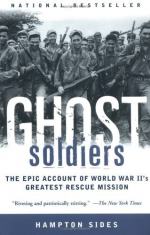
|
| Name: _________________________ | Period: ___________________ |
This test consists of 15 multiple choice questions and 5 short answer questions.
Multiple Choice Questions
1. Where were the 6th Army headquarters that the Rangers reached a few minutes after starting their mission on January 28?
(a) Lingayen.
(b) Dagupan.
(c) Binmaley.
(d) Mangaldan.
2. What type of vehicle did Colonel Motoo Nakayama arrive in to discuss surrender with General King?
(a) A Lincoln Continental.
(b) A Jeep.
(c) A Mercedes Benz.
(d) A Cadillac.
3. Who had found a monkey in New Guinea and brought it with him to the Philippines?
(a) Bert Bank.
(b) Tommie Thomas.
(c) Eugene Dykes.
(d) Robert Prince.
4. By January 28, toward what city were the Japanese making a ragged retreat?
(a) San Juan.
(b) Bambang.
(c) Agoo.
(d) Baguio.
5. What was the ward called where they placed critically ill patients at Camp O'Donnell?
(a) Death Row.
(b) Death Ward.
(c) St. Peter's Ward.
(d) Zero Ward.
6. How old were many of the Japanese soldiers guarding Abie Abraham and his comrades?
(a) 17 to 18 years of age.
(b) 25 to 30 years of age.
(c) 40 to 45 years of age.
(d) 30 to 35 years of age.
7. What other attack occurred on the same day as the attack on Luzon?
(a) The Battle of Midway.
(b) The Battle of Imphal.
(c) The Battle of Guadalcanal.
(d) Pearl Harbor.
8. How many Chinese was Colonel Tsuji said to be personally responsible for their deaths?
(a) 5,000.
(b) 4,000.
(c) 2,000.
(d) 6,000.
9. Who refused to go into the air-raid shelters on December 14?
(a) C. C. Smith.
(b) Quentine Devore.
(c) Robert Pritchford.
(d) Vernon Booth.
10. What was Colonel Tsuji called by the young Japanese officers?
(a) The Spy.
(b) The Hatchet Man.
(c) The God of Operations.
(d) The Butcher.
11. Where were the prisoners loaded into boxcars?
(a) Santa Ana.
(b) San Simon.
(c) Santa Rita.
(d) San Fernando.
12. When was Abie Abraham shipped to the Philippines?
(a) 1942.
(b) 1940.
(c) 1939.
(d) 1941.
13. What was the name of the monkey brought from the Philippines from New Guinea?
(a) Weasel.
(b) Mike.
(c) Keezel.
(d) Spike.
14. What was the date when Abie Abraham and his comrades had to stand near water, but could not drink?
(a) April 22, 1942.
(b) April 10, 1942.
(c) April 2, 1942.
(d) April 30, 1942.
15. How many prisoners loaded into each boxcar?
(a) 50 prisoners.
(b) 100 prisoners.
(c) 125 prisoners.
(d) 75 prisoners.
Short Answer Questions
1. What type of planes did the prisoners see after the air-raid alarm sounded on December 14?
2. At Puerto Princesa Prison Camp, what indicates that an air raid was imminent?
3. Where did the trains take prisoners?
4. What was at the rear of the soldiers who were trying to flee to Mariveles?
5. General Homma foresaw that American prisoners would need to move from Bataan. How many prisoners did he estimate would need evacuation?
|
This section contains 411 words (approx. 2 pages at 300 words per page) |

|




